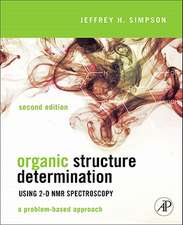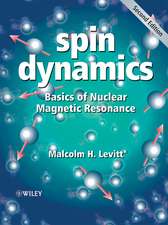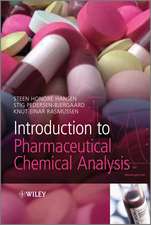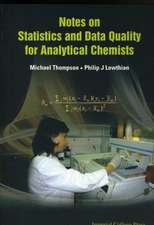Computational Methods for Sensor Material Selection: Integrated Analytical Systems
Editat de Margaret A. Ryan, Abhijit V. Shevade, Charles J. Taylor, M. L. Homer, Mario Blanco, Joseph R. Stetteren Limba Engleză Paperback – 20 noi 2014
| Toate formatele și edițiile | Preț | Express |
|---|---|---|
| Paperback (1) | 698.80 lei 6-8 săpt. | |
| Springer – 20 noi 2014 | 698.80 lei 6-8 săpt. | |
| Hardback (1) | 952.40 lei 6-8 săpt. | |
| Springer – 16 oct 2009 | 952.40 lei 6-8 săpt. |
Preț: 698.80 lei
Preț vechi: 822.12 lei
-15% Nou
Puncte Express: 1048
Preț estimativ în valută:
133.71€ • 145.70$ • 112.67£
133.71€ • 145.70$ • 112.67£
Carte tipărită la comandă
Livrare economică 23 aprilie-07 mai
Preluare comenzi: 021 569.72.76
Specificații
ISBN-13: 9781489984166
ISBN-10: 148998416X
Pagini: 336
Ilustrații: XV, 319 p.
Dimensiuni: 155 x 235 x 18 mm
Greutate: 0.47 kg
Ediția:2010
Editura: Springer
Colecția Springer
Seria Integrated Analytical Systems
Locul publicării:New York, NY, United States
ISBN-10: 148998416X
Pagini: 336
Ilustrații: XV, 319 p.
Dimensiuni: 155 x 235 x 18 mm
Greutate: 0.47 kg
Ediția:2010
Editura: Springer
Colecția Springer
Seria Integrated Analytical Systems
Locul publicării:New York, NY, United States
Public țintă
Professional/practitionerCuprins
First Principles Methods For Materials Evaluation.- Introduction: Experimental Methods in Chemical Sensor and Sensor Array Evaluation and Development.- Electromechanical and Chemical Sensing at the Nanoscale: DFT and Transport Modeling.- Quantum Mechanics and First-Principles Molecular Dynamics Selection of Polymer Sensing Materials.- Prediction of Quartz Crystal Microbalance Gas Sensor Responses Using Grand Canonical Monte Carlo Method.- Computer-Aided Design of Organic Host Architectures for Selective Chemosensors.- First Principles Molecular Modeling of Sensing Material Selection for Hybrid Biomimetic Nanosensors.- Statistical And Multivariate Methods For Materials Evaluation.- Development of New Sensing Materials Using Combinatorial and High-Throughput Experimentation.- Chemical Sensor Array Response Modeling Using Quantitative Structure-Activity Relationships Technique.- Design and Information Content of Arrays of Sorption-Based Vapor Sensors Using Solubility Interactions and Linear Solvation Energy Relationships.- Designing Sensing Arrays.- A Statistical Approach to Materials Evaluation and Selection for Chemical Sensor Arrays.- Statistical Methods for Selecting the Components of a Sensing Array.- Hybrid Arrays for Chemical Sensing.- Future Directions.- Future Directions.
Recenzii
From the reviews:
“The book is written in a comprehensible manner. Each chapter contains descriptive examples. After a short introduction, the book gives very detailed information about scientific issues in each topic. Besides quantum mechanical principles, statistical approaches are covered as well. Therefore, all important topics for selecting sensing materials for chemical vapor sensing are covered. Owing to this excellent collection, the book is recommended for all scientists working on chemical vapor sensing.” (Felix Kolarov, Analytical and Bioanalytical Chemistry, Vol. 397, May, 2010)
“The book is written in a comprehensible manner. Each chapter contains descriptive examples. After a short introduction, the book gives very detailed information about scientific issues in each topic. Besides quantum mechanical principles, statistical approaches are covered as well. Therefore, all important topics for selecting sensing materials for chemical vapor sensing are covered. Owing to this excellent collection, the book is recommended for all scientists working on chemical vapor sensing.” (Felix Kolarov, Analytical and Bioanalytical Chemistry, Vol. 397, May, 2010)
Textul de pe ultima copertă
In Computational Methods for Sensor Material Selection, experts discuss the design and selection of active sensing surfaces for chemical sensors, particularly sensors used in vapor sensing arrays or electronic noses.
Part I covers first principles.
Part II focuses on identifying and evaluating candidate sensing materials and covers such topics as calculations of sensor-analyte interactions, statistical and semi-empirical methods based on characteristics of sensing material and analyte, and new experimental methods.
Part III advises on selecting materials for inclusion in arrays by use of statistical methods and algorithm-based methods for evaluating the array response to target analytes.
This book will appeal to researchers in academia and industry involved in chemical vapor sensing and monitoring. Also, it will be of special interest to those who are developing devices based on chemical sensing arrays.
Part I covers first principles.
Part II focuses on identifying and evaluating candidate sensing materials and covers such topics as calculations of sensor-analyte interactions, statistical and semi-empirical methods based on characteristics of sensing material and analyte, and new experimental methods.
Part III advises on selecting materials for inclusion in arrays by use of statistical methods and algorithm-based methods for evaluating the array response to target analytes.
This book will appeal to researchers in academia and industry involved in chemical vapor sensing and monitoring. Also, it will be of special interest to those who are developing devices based on chemical sensing arrays.
Caracteristici
One of the first volumes in comprehensive new Springer series Integrated Microanalytical Sytems, edited by R. Potyrailo Complements the experimental approach in other series volume, "Combinatorial methods for sensor materials," by Potyrailo and Mirsky First book of its kind, exclusively devoted to the selection of sensors and components for a chemical sensing array Applications of "electronic noses" include process control, medical diagnosis, and environmental monitoring Includes supplementary material: sn.pub/extras



























